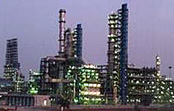Executive Summary

High Uptime and Maintainability Secured
by Full-fledged Automation Platform
at Indian Refinery
HPCL-Mittal Energy Limited (HMEL) is a joint venture between Hindustan Petroleum Corporation Limited and Mittal Energy Investment Pte Ltd, a Lakshmi N Mittal company that is based in Singapore. HMEL has built and currently operates the Guru Gobind Singh refinery, which is located near Bathinda in India's Punjab region. This new refinery has a production capacity of 9 million tons per annum (the equivalent of 180,000 bpd) and complies with the Euro IV emission norms. This is a zero bottom plant, with a very high Nelson Complexity Index. The refinery facilities include a polypropylene unit (PPU) that utilizes the Novolen® gas-phase polypropylene (PP) process and is capable of producing 440,000 tons per year of homo-polymer PP.
HMEL produces an entire range of PP homo-polymers. The refinery's state-of-the art delayed coker unit (DCU) produces a high sulfur petroleum coke (pet coke) derivative. The sulfur recovery unit produces very high quality sulfur in powder and lump form. The other notable deliverable is a high yield of environmentally friendly liquid petroleum gas (LPG) for household and commercial customers in the northern region of the country.
For the monitoring and control of the entire Guru Gobind Singh refinery, HMEL selected an integrated solution from Yokogawa consisting of the CENTUM VP state-of-the-art distributed control system, the ProSafe-RS safety instrumented system, the Plant Resource Manager (PRM) asset management system, the Exasmoc, Exarqe, and fitOMS advanced process control (APC) packages, FOUNDATION™ fieldbus instruments, and an operator training simulator (OTS). Yokogawa India oversaw and implemented their engineering, installation, and commissioning, and the refinery has performed flawlessly since coming online in early 2012.

The central control room
The Challenges and the Solutions
1. Maintenance
This full scale refinery has a total of nearly 12,000 field instruments. To ensure the efficient utilization and maintenance of these assets, HMEL decided to use the FOUNDATION fieldbus technology in tandem with the PRM asset management package. With this solution, personnel in the central control room can monitor the performance of these field assets and diagnose their condition. PRM also has a control valve signature analysis function. With these capabilities, the HMEL maintenance team is able to adopt a proactive maintenance approach whereby problems are spotted before a field device or control valve fails and maintenance can be scheduled to be performed at an opportune time. In addition to improving plant uptime, this eliminates the need for many manual checks of devices in the field, reducing field operator workload.
2. Safety
Safety is always a paramount concern at an oil refinery. ProSafe-RS is SIL-3 certified by TUV for the management of the emergency shutdown (ESD) system and the fire & gas system (FGS), and is fully integrated with the DCS. In addition to the many benefits of an integrated human machine interface (HMI) for DCS and ESD, the integration of DCS and ESD also allows the seamless exchange of signals between the DCS interlocks and the ESD logic, especially in the Poly Propylene units which requires many signals and status of ESD logics in the DCS controllers.
3. Efficiency and product quality
HMEL utilizes APC packages together with the DCS to improve efficiency and ensure the highest levels of product quality. The Exasmoc multivariable optimization controller and the Exarqe robust quality estimator are used to reduce the amount of steam consumed by the continuous distillation unit (CDU), DCU, and fluidized catalytic cracking unit (FCCU) and to help ensure the steady operation of the entire refinery.
Blending is the last step in the process of producing finished products from crude oil. Quality control for the finished products is one of the most important steps in the refining process. At the HMEL refinery, Yokogawa's fitOMS (future integration technology for oil movement system) APC solution works in conjunction with near infrared analyzers (NIR) to optimize mid sulfur (MS) oil blending and high speed diesel (HSD) blending. This ensures that the finished products are kept within the targeted blend ranges and that this is done in the most cost-effective way.
The package includes an OTS for a total of 10 process units. Built by Omega Simulation Co., Ltd., this is a DCS direct connect type OTS used in operator training that also can function as a DCS-programmable logic controller (PLC) to check out control strategies. The early delivery of the OTS ensured that the operators could familiarize themselves with the systems before the plant commissioning. The specific process units covered by the OTS are:
- CDU, vacuum distillation unit (VDU)
- Naphtha hydrotreater (NHT)
- Isomerization (ISOM) unit
- Catalytic reformer
- Diesel hydrotreater (DHDT)
- Vacuum gas oil – hydrotreater) (VGO-HDT)
- Fluidized catalytic cracking – propylene recovery unit (FCC-PRU)
- Polypropylene
- Hydrogen generation unit (HGU)
- DCU & sulfur recovery unit (SRU)
Client satisfaction parameters:
- Robust best-in-class DCS/PLC solution
- Robust, fast Vnet/IP network
- Control of field instruments on FOUNDATION fieldbus closed loops
- Integrated DCS/ESD PLC network
- Robust HMI used as direct node on DCS network
- Remote PLC I/O for hardwired console in CCR
- Able to perform PRM control valve signature analysis and partial stroke testing of shutdown valves from CCR
- Redundant ProSafe-RS architecture for both ESD and FGS, from I/O level to CPU
- ProSafe-RS sequence of events (SOE) functionality with 1-msec event resolution for trip analysis and troubleshooting
Project details:
| Total system tags: | 41,000 |
|---|---|
| Total DCS closed loops (conventional): | 2,350 |
| Total devices on FOUNDATION fieldbus: | 12,000 |
| Total FOUNDATION fieldbus segments: | 2,240 |
| Maximum number of devices per segment: | 9 |
| Total FOUNDATION fieldbus closed loops: | 1,210 |
| Total HMIs: | 82 |
| Total ESD and FGS PLC I/Os (ProSafe-RS): | 16,240 |
| Video wall size in main control room: | 48,854 mm (W) x 2,200 mm (H) (80 x 60" displays) |
Customer Satisfaction
P.S. Prasad, General Manager, Maintenance – Control & Instrumentation at HMEL, commented, "The CENTUM VP system supplied by Yokogawa forms a complete integrated network connecting all the process units and the central control room. Since its commissioning in 2012, the system has been very robust and has withstood all plant disturbances. PRM has proven to be an extremely effective maintenance tool as the majority of the closed loops are based on FOUNDATION fieldbus. The ESD and FGS systems designed to work with ProSafe-RS have performed as specified. Yokogawa has been very forthcoming with its support and maintenance of the integrated automation system, ensuring high uptime."

行业
-
油气下游
近年来,油气下游产业面临着越来越多的挑战。这些挑战包括待加工原料的特性变化、工艺设施及设备的老化、能源成本的上升、缺乏能够使炼油厂安全有效运行的熟练技术工人,以及市场和客户的需求不断变化。
多年来,横河与许多下游公司合作,致力于提供应对这些挑战和问题的工业解决方案。横河的VigilantPlant解决方案帮助工厂投资者尽可能实现较大的盈利能力和工厂内可持续的安全。
-
精炼
在不断变化的市场中,炼油厂不仅是原油加工单位,而且是利润部门。同时,人们强烈意识到炼油厂设施安全性的重要。为了实现盈利、效率及环境保护的长期目标,需要包括计划、调度、管理和控制的总体生产解决方案。凭借在自动化领域多年积累的专业知识,横河可以为您提供解决方案,改善操作。
相关产品&解决方案
-
SIS (SIL3) ProSafe-RS
ProSafe-RS是获得德国认证机构(TÜV)认证的安全仪表系统,符合IEC 61508中确定的安全完整性等级(SIL)3。它已经在2400多个项目中安装使用,涵盖从大型集成过程自动化项目到独立解决方案等多种项目类型。
-
先进控制及预估平台(先进过程控制)
先进控制及预估统一平台将多变量控制、质量预估、复杂的自定义运算以及操作员用户界面设计等功能整合到一个应用中,这就大幅减少了部署时间,使维护系统鲁棒性变得简单。
-
工厂资源管理系统(PRM)
工厂资源管理系统(PRM)是横河电机用于资产管理的一个关键平台。该平台旨在改进操作和维护,通过获得更大的可预测性,使工厂资产的可靠性和可用性增强。
-
安全仪表系统 (SIS)
安全仪表系统 (SIS) 可保护人员、环境和资产。横河电机的SIS和相关安全解决方案被广泛应用于紧急停车、火灾与燃气、燃烧器管理和HIPPS等领域。
-
集散控制系统(DCS)
横河电机的集散控制系统(DCS) 可实现工业过程的自动化和控制,并提高业务绩效。30,000多套系统的经营者选择采用横河电机的DCS来实现其生产目标。

